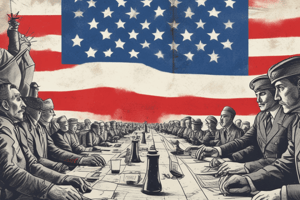Podcast
Questions and Answers
What was the primary purpose of the policy of containment practiced by the United States during the Cold War?
What was the primary purpose of the policy of containment practiced by the United States during the Cold War?
- To promote the spread of democracy in Eastern Europe.
- To prevent the spread of Communism abroad. (correct)
- To support economic growth in Communist countries.
- To establish military alliances with Communist nations.
Which act was passed to limit the power of labor unions, perceived as potential incubators of Communism?
Which act was passed to limit the power of labor unions, perceived as potential incubators of Communism?
- The Fair Labor Standards Act
- The National Labor Relations Act
- The Taft-Hartley Act (correct)
- The Wagner Act
Who was primarily responsible for investigating and detaining suspected Communist sympathizers in America?
Who was primarily responsible for investigating and detaining suspected Communist sympathizers in America?
- The House Un-American Activities Committee (HUAC)
- The Department of Justice
- The Central Intelligence Agency (CIA)
- The Federal Bureau of Investigation (FBI) (correct)
What was the effect of Joseph McCarthy's actions during the Second Red Scare?
What was the effect of Joseph McCarthy's actions during the Second Red Scare?
What was a common belief held by many Americans regarding Communism during the Cold War?
What was a common belief held by many Americans regarding Communism during the Cold War?
Flashcards are hidden until you start studying
Study Notes
Cold War and Containment Policy
- Containment policy aimed to prevent the spread of Communism internationally and domestically.
- Communism advocates for collective ownership and distribution based on needs but was misused by leaders like Joseph Stalin, resulting in mass violence.
Rise of Anti-Communist Sentiment
- Post-World War II, fears of Communist infiltration led to heightened anxiety within American society.
- J. Edgar Hoover, head of the FBI, initiated secret investigations and detentions of suspected Communist sympathizers.
Labor Unions and Legislative Actions
- Labor unions were regarded as potential nests for Communist ideology.
- The Taft-Hartley Act was enacted to curtail the influence and power of labor unions in response to these fears.
The Second Red Scare
- Joseph McCarthy intensified fears during the Second Red Scare, causing Americans to suspect each other of Communist affiliations.
- Daily interactions were scrutinized as individuals reevaluated relationships through the lens of potential Communist loyalty.
Governmental Investigations
- The House Un-American Activities Committee (HUAC) played a crucial role in investigating citizens accused of Communist sympathies.
- Concerns were rooted in the belief that Communism threatened the stability and values of the United States.
Broader Motivations
- Many politicians exploited the fear of Communism for personal or political gain.
- General public sentiment was largely driven by the perception of Communism as a godless ideology that incited violence and disorder.
Studying That Suits You
Use AI to generate personalized quizzes and flashcards to suit your learning preferences.




